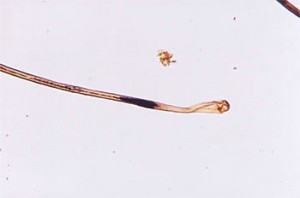
Photomicrograph of postmortem root band. Source: Douglas W. Deedrick and Sandra L. Koch, “Microscopy of Hair Part 1: A Practical Guide and Manual for Human Hairs,” Forensic Science Communications 6(1) (January 2004).
During the 2011 Casey Anthony trial, an FBI hair analyst testified that a hair recovered from Anthony’s car trunk probably came from a dead body. The expert based her conclusion on the presence of a darkened band at the root portion of the hair. This postmortem hair banding is a sign of decomposition.
Evidence of hair with postmortem banding also plays a role in a case described in an August 2012 posting on the OpposingViews website. In 1985, Nassau County (New York) police found two hairs in a van. The hairs matched the hair of a 16-year old, who had been recently raped and murdered. The recovered hairs linked three men to the crime. During a 1986 trial, prosecutors argued that the presence of the hairs in the van proved that the three male defendants had used the van to abduct their victim, rape her, killer her, and dump her body in the woods within a span of a few hours. They were convicted.
About 20 years later, DNA tests cleared the three men, and they filed wrongful conviction cases. The judge allowed the plaintiffs to call expert witnesses to testify that traces of postmortem root banding found on the hairs strongly indicate that the hairs originated from the autopsy room. In other words, the evidence had been planted in the van.
Despite the considerable qualifications of the experts, the judge decided that the science surrounding postmortem root banding (PMRB) is inconclusive.
“The idea that PMRB takes several days to develop (and thus that it could not have developed in the short time [that the victim had been in the] van) has not yet been established by scientific standards of proof,” the judge wrote.
Opinions about the admissibility of postmortem root banding vary among judges. During the 2005 retrial of one of the three men, a Nassau County judge held a hearing on the scientific basis of postmortem root banding, and decided to allow the defendant to present the evidence to the jury. If you’re thinking about including the controversial postmortem root banding evidence into your story, then you should review the judge’s consideration about the value of the evidence in People v. Kogut, which can be found on the Justia.com website.
